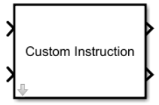Custom Instruction
Create custom ladder logic instruction
Libraries:
Description
The Custom Instruction block implements user-defined instructions for a
ladder diagram model. When the rung conditions are true, the block executes the specified
custom logic. You can save these instructions in a user-defined library named
plcuserlib.slx. You can also import, simulate, and export your ladder
logic instructions by using your custom blocks saved in plcuserlib.slx
library.
Ports
Input
Output
Parameters
Version History
Introduced in R2020a
